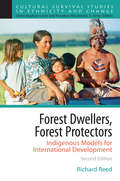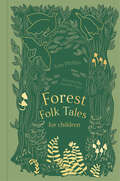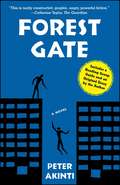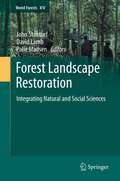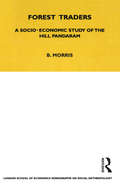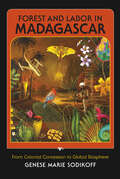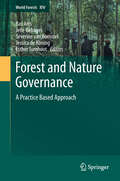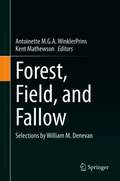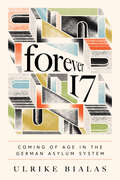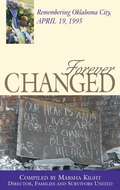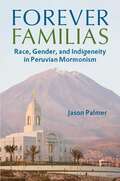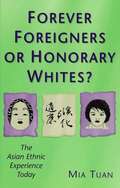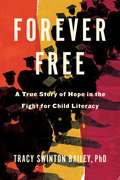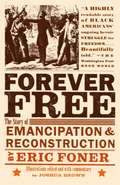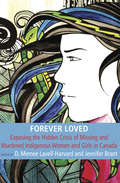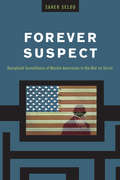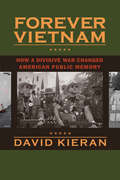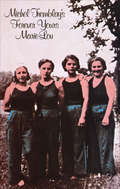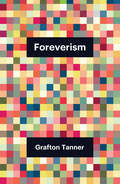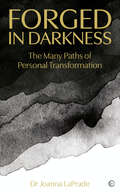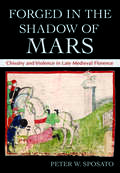- Table View
- List View
Forensische Psychologie in Deutschland: Zeugenschaft des Verbrechens, 1880-1939
by Heather WolfframDieses Buch untersucht die Entstehung und frühe Entwicklung der forensischen Psychologie in Deutschland vom späten neunzehnten Jahrhundert bis zum Ausbruch des Zweiten Weltkriegs und beleuchtet die interdisziplinären Anfänge und die umstrittene Entwicklung des Fachs. Ursprünglich als Psychologie aller an Strafverfahren Beteiligten gedacht, versprach diese neue Disziplin, sich von der ausschließlichen Konzentration auf den Kriminellen zu lösen und eine ganzheitliche Sichtweise der Auswirkungen menschlicher Fehlbarkeit auf die Strafjustiz zu bieten. Wie in diesem Buch dargelegt wird, war die forensische Psychologie in der Zwischenkriegszeit jedoch weitgehend zu einer Psychologie des Zeugen geworden; ihr Fokus wurde durch die Anforderungen des Gerichtssaals eingeengt. Anhand detaillierter Studien des Berchtold-Prozesses von 1896 und des Frenzel-Prozesses von 1930 geht das Buch der Frage nach, ob die Spannungen zwischen Psychiatrie, Psychologie, Gerichtsmedizin, Pädagogik und Recht in Bezug auf psychologisches Fachwissen in der Gerichtspraxis präsent waren, und untersucht, warum sich bis 1939 noch kein klarer Sieger im "Kampf um die forensische Psychologie" abzeichnete.
Forest Dwellers, Forest Protectors: Indigenous Models for International Development
by Richard ReedThe Guarani of Paraguay have survived over four centuries of contact with the commercial system, while keeping in tact their traditions of leadership, religion and kinship. This concise ethnography examines how the Guarani have adapted over time, in concert with Paraguay's subtropical forest system. New To This Edition: Expanded historical background and updated demographic information on the Guarani brings the research to the present day (Chapter 1). Expands and strengthens the discussion of "sustainability" to include more recent advances in the concept (Chapter 1), and introduces the idea of "subsidy from nature" into the discussion of conventional tropical development (Chapter 3). Develops the discussion of women's labor in horticulture (Chapter 3). Analyzes the effects of indigenous mixed agro-forestry in stemming the high rates of Paraguayan deforestation of the 1990s (Chapter 4). Discusses the recent globalization of the yerba mate market, and the economy's effecton Paraguay's protected areas (Chapter 4). Describes Guarani ethnic federations as a means to engage the national and international political institutions (Chapter 4). Explores the rapid growth in Guarani population in native communities, which results from lower infant mortality, more land pressure and more reliable census data (Chapter 4). This brief introductory text makes the ideal supplementary text for students of anthropology.
Forest Folk Tales for Children
by Tom Phillips Amanda VigorNestled within our green and pleasant land lies pockets of emerald trees. Their roots search deep into the ground and the branches reach high towards the sun. For centuries some of these have stood watching and listening to the human creatures living among them, hearing their stories and remembering. What mysteries could these woodlands tell if the trees could speak? Stories of brave deeds and foolish, star-crossed lovers, of monsters, giants and witches, hobs and kings. Discover the secrets of our forests in this engaging collection of folk tales.
Forest Gate
by Peter AkintiA shattering, poetic and raw first novel set among young Somalian refugees in the slums of London -- beginning with a double suicide and ending with a rebirth. In a community where poverty is kept close and passed from one generation to the next, two teenage boys, best friends, stand on top of twin tower blocks. Facing each other across the abyss of London's urban sprawl, they say their good-byes and jump. One dies. The other, alternating with the sister of the deceased, narrates this novel. James gives us a window into the inner city -- his mom is a crack addict, his gang "brothers" force him to kill another black boy. Meina describes with feeling her family history in Somalia: after her parents are killed before her eyes, her village aunt sells her to six husbands -- before she is even a teenager. Desperate to rebuild their lives, James and Meina set out to find the place for which every child longs -- home. Brutal and shockingly violent in places, rambunctious and lively in others and slyly, dryly witty in yet others, Meina and James's journey toward life through their past is ultimately a powerful story of redemptive love and the debut of an extraordinary literary talent.
Forest Landscape Restoration
by David Lamb John Stanturf Palle MadsenRestoration ecology, as a scientific discipline, developed from practitioners' efforts to restore degraded land, with interest also coming from applied ecologists attracted by the potential for restoration projects to apply and/or test developing theories on ecosystem development. Since then, forest landscape restoration (FLR) has emerged as a practical approach to forest restoration particularly in developing countries, where an approach which is both large-scale and focuses on meeting human needs is required. Yet despite increased investigation into both the biological and social aspects of FLR, there has so far been little success in systematically integrating these two complementary strands. Bringing experts in landscape studies, natural resource management and forest restoration, together with those experienced in conflict management, environmental economics and urban studies, this book bridges that gap to define the nature and potential of FLR as a truly multidisciplinary approach to a global environmental problem. The book will provide a valuable reference to graduate students and researchers interested in ecological restoration, forest ecology and management, as well as to professionals in environmental restoration, natural resource management, conservation, and environmental policy.
Forest Traders: A Socio-Economic Study of the Hill Pandaram
by Brian MorrisThe first ethnographic study of a community with structured trading relationships, the nomadic forest community of the Hill Pandarm.
Forest and Labor in Madagascar: From Colonial Concession to Global Biosphere
by Genese Marie SodikoffA study of the demands of economic development and ecological conservation on the African island country.Protecting the unique plants and animals that live on Madagascar while fueling economic growth has been a priority for the Malagasy state, international donors, and conservation NGOs since the late 1980s. Forest and Labor in Madagascar shows how poor rural workers who must make a living from the forest balance their needs with the desire of the state to earn foreign revenue from ecotourism and forest-based enterprises. Genese Marie Sodikoff examines how the appreciation and protection of Madagascar’s biodiversity depend on manual labor. She exposes the moral dilemmas workers face as both conservation representatives and peasant farmers by pointing to the hidden costs of ecological conservation.“Sodikoff takes us deep into the underbelly of conservation in one of the world’s biodiversity “hot-spots.” It is a world of timber barons, logging gangs, corrupt state functionaries, international conservation experts, worker-peasants, and poachers. She paints eastern Madagascar as a frontier of dispossession, exploitation, and violence. The plundering of the Mananara protected area is seen, in a brilliantly original way, from the subaltern vantage point of forest workers and conservation labor. Forest and Labor places present day conservation on the larger canvas of a century of forest-based social relations of labor that have entered into the making of what Sodikoff calls neoliberal conservation. It is a magnificently rich historical and ethnographic accounting of what passes as the making of global biosphere reserves. A tour de force.” —Michael Watts, UC Berkeley“An important and lively contribution to the study of “green neoliberalism.” An obvious choice for undergraduate teaching on ecology, rights, international political economy, development, and a host of other topics.” —David Graeber, University of London“Brings a whole new angle and nuance to the crucial debates over conservation and development. Applicable not just to lush, humid eastern Madagascar, but all around the globe.” —Christian Kull, Monash University“Those interested in conservation, tropical rainforest ecology, international political economy, and sustainable development will find Forest and Labor in Madagascar an insightful case study.” —Choice
Forest and Nature Governance
by Jelle Behagel Bas Arts Jessica De Koning Esther Turnhout Séverine Van BommelToday, problems such as deforestation, biodiversity loss and illegal logging have provoked various policy responses that are often referred to as forest and nature governance. In its broadest interpretation, governance is about the many ways in which public and private actors from the state, market and/or civil society govern public issues at multiple scales. This book takes a fresh perspective on the study of forest and nature governance. Departing from 'practice theory', and building upon scholars like Giddens, Bourdieu, Reckwitz, Schatzki and Callon, it seeks to move beyond established understandings of institutions, actors, and knowledge. In so doing, it not only presents an innovative conceptual and methodological framework for a practice based approach, but also rich case studies and ethnographies. Finally, this book is about how actors involved in governance talk about and work with trees, forests, biodiversity, wildlife, and so on, while acting upon forest policies, environmental discourses, codes of conduct, or scientific insights.
Forest of Tigers: People, Politics and Environment in the Sundarbans
by Annu JalaisAcclaimed for its unique ecosystem and Royal Bengal tigers, the mangrove islands that comprise the Sundarbans area of the Bengal delta are the setting for this pioneering anthropological work. The key question that the author explores is: what do tigers mean for the islanders of the Sundarbans? The diverse origins and current occupations of the local population produce different answers to this question – but for all, ‘the tiger question’ is a significant social marker. Far more than through caste, tribe or religion, the Sundarbans islanders articulate their social locations and interactions by reference to the non-human world – the forest and its terrifying protagonist, the man-eating tiger. The book combines rich ethnography on a little-known region with contemporary theoretical insights to provide a new frame of reference to understand social relations in the Indian subcontinent. It will be of interest to scholars and students of anthropology, sociology, development studies, religion and cultural studies, as well as those working on environment, conservation, the state and issues relating to discrimination and marginality.
Forest, Field, and Fallow: Selections by William M. Denevan
by Kent Mathewson Antoinette M. G. A. WinklerPrinsThis volume aims to present the essential work of geographer and historical ecologist William M. Denevan to explain the impact and influence his thinking had on the conceptual advancement not only in his own discipline, but in a range of related disciplines such as anthropology, archaeology, and environmental history. The book is organized around eight themes, demonstrating Denevan’s early and profound insights on topics that remain of current relevance today, and the scholarly impact his writing had on subsequent scholarship. The book is unique because it offers commentary from active scholars who address the impacts of Prof. Denevan's thinking and work on contemporary environmental and ecological issues, with a focus on several groundbreaking themes (e.g. historical demography, agricultural landforms, cultural plant geography, human environmental impacts, indigenous agro-ecology, tropical agriculture, livestock and landscape, and synthetic contributions). This book will be of interest to a range of scholars in geography, anthropology, archaeology, history, and ecology, as well as to environmental managers and practitioners, especially those working for non-profit organizations and government organizations tasked with finding ways to adapt to global environmental change.
Foresters, Borders, and Bark Beetles: The Future of Europe's Last Primeval Forest
by Eunice Blavascunas“A compelling investigation of the pasts and possible futures of a critical ecosystem in an era of globalization and rising nationalism.” —Andrew S. Mathews, author of Instituting NatureIn Europe’s last primeval forest, at Poland’s easternmost border with Belarus, the deep past of ancient oaks, woodland bison, and thousands of species of insects and fungi collides with authoritarian and communist histories.Foresters, biologists, environmentalists, and locals project the ancient Bialowieza Forest as a series of competing icons in struggles over memory, land, and economy, which are also struggles about whether to log or preserve the woodland; whether and how to celebrate the mixed ethnic Polish/Belarusian peasant past; and whether to align this eastern outpost with ultraright Polish political parties, neighboring Belarus, or the European Union. Eunice Blavascunas provides an intimate ethnographic account, gathered in more than 20 years of research, to untangle complex forest conflicts between protection and use. She looks at which pasts are celebrated, which fester, and which are altered in the tumultuous decades following the collapse of communism.Foresters, Borders, and Bark Beetles is a timely and fascinating work of cultural analysis and storytelling that textures its ethnographic reading of people with the agency of the forest itself and its bark beetle outbreaks, which threaten to alter the very composition of the forest in the age of the Anthropocene. “Through vivid storytelling, Eunice Blavascunas illuminates the durability of struggles around national identity and history—and the ways those struggle shape debates over ecology and nature conservation—in one of Europe’s quintessential borderlands.” —Katrina Z. S. Schwartz, author of Nature and National Identity after Communism
Forever 17: Coming of Age in the German Asylum System (Ethnographic Encounters and Discoveries)
by Ulrike BialasAn exploration of how age affects the experience and life prospects of asylum-seekers in Germany. Heartbreaking images of children in distress have propelled some of the most urgent calls for action on immigration crises, and that compassion often affects how state asylum policies are structured. In Germany, for example, the immigration system is engineered to protect minors, which leads to unintended consequences for migrants. In Forever 17, Ulrike Bialas follows young African and Central Asian migrants in Germany as they navigate that system. Without official paperwork or even, in many cases, knowledge of their exact age, migrants must decide how to present their complicated life stories to government officials. They quickly realize that their age can have an outsized effect on the outcome of their cases. A migrant under 18, for example, can’t be deported, but might instead be placed in a youth home, where they will be subject to strict curfew laws. An 18-year-old adult, on the other hand, can get permission to work, but not opportunities to go to school. Regardless of their age—actual or assumed—migrants face great difficulties. Those classified as minors must live with the psychological burden of being treated like children, while those classified as adults must live without the practical support and legal protections reserved for minors. The significance of age stands in stark contrast to the ambiguities inherent in its determination. Though Germany’s infamous bureaucracy is designed to issue clear statements about refugees and migrants, the truth is often more complicated, and officials are forced to grapple with the difficult implications of their decisions. Ultimately, Bialas shows, policies surrounding asylum seekers fall dramatically short of their humanitarian ideals. Even those policies designed to help the most vulnerable can lead to outcomes that drastically limit the possibilities for migrants in real need of protection and keep them from leading fulfilling lives.
Forever Barbie: The Unauthorized Biography Of A Real Doll
by M.G. LordBarbie is a strong, independent doll. But is she a feminist icon? It’s complicated. Since her introduction in 1959, Barbie’s impact has been revolutionary. Far from being a toy designed by men to oppress women, she was a toy invented by women to teach women what was expected of them, for better or for worse. Whether tarred-and-glittered as antifeminist puffery or celebrated as a feminist icon (or, at any rate, an important cultural touchstone in understanding feminism) Barbie has undeniably influenced generations of girls. In Forever Barbie, cultural critic, investigative journalist, and first-generation Barbie owner M. G. Lord uncovers the surprising story behind Barbie’s smash success. Revealing her low origins as “Bild Lilli,” a risqué doll for adults sold as a gag gift in postwar Germany, Forever Barbie traces Barbie’s development and transformation, through countless makeovers and career changes, into an international pop culture icon and now “traditional toy.” Though not every doll in the line has been a hit—with pregnant Midge and Growing up Skipper among the more intriguing disasters—Barbie’s endurance, Lord writes, speaks as much to Mattel’s successful marketing as it does to our society’s overall ambivalence toward femininity. With new accessories, including a preface on the latest developments in the Barbieverse, Forever Barbie “will make you think of America’s most celebrated plastic doll in ways you never have before” (Susan Faludi).
Forever Changed: Remembering Oklahoma City, April 19, 1995
by Marsha KightRoyalties from Forever Changed will aid those survivors and family members who have contributed to this book. Much has been written about the Oklahoma City bombing and how 168 people were killed. But news accounts often fail to put a face on the victims or to show the significance of their lives and contributions to their families and communities. Little is known about the lives of the many who survived the blast and the families of those who didn't. The tomorrows of so many ordinary people have been irreparably altered by a single act of domestic terrorism. Three years in the making, Forever Changed is the exclusive volume that brings together survivors and family members of victims. This powerful work tells the special stories of those who died, the pain endured by their families, and the ongoing struggles of the survivors a circle of grieving and hope that reaches far beyond the heartland. These unique first person accounts lucidly illustrate the goodness that was lost on April 19, 1995, the legacies that remain, and the courage of all those who were affected by the bombing. Internationally recognized victim's rights advocate Marsha Kight and her assistant, Lori Doggett, collected these stories and photographs from the many families in their home city and kept them in storage until the juries were chosen for the perpetrators' trials. Kight also contributes the story of her daughter, Frankie Merrell, 23, who was killed in the blast.
Forever Familias: Race, Gender, and Indigeneity in Peruvian Mormonism
by Jason PalmerPeruvian members of the Church of Jesus Christ of Latter-day Saints face the dilemma of embracing their faith while finding space to nourish their Peruvianness. Jason Palmer draws on eight years of fieldwork to provide an on-the-ground look at the relationship between Peruvian Saints and the racial and gender complexities of the contemporary Church. Peruvian Saints discovered that the foundational ideas of kinship and religion ceased being distinct categories in their faith. At the same time, they came to see that LDS rituals and reenactments placed coloniality in opposition to the Peruvians’ indigenous roots and family against the more expansive Peruvian idea of familia. In part one, Palmer explores how Peruvian Saints resolved the first clash by creating the idea of a new pioneer indigeneity that rejected victimhood in favor of subtle engagements with power. Part two illuminates the work performed by Peruvian Saints as they stretched the Anglo Church’s model of the nuclear family to encompass familia.
Forever Foreigners or Honorary Whites? The Asian Ethnic Experience Today
by Mia TuanTuan examines the salience and meaning of ethnicity for later generation Chinese and Japanese Americans, and asks how the racialized ethnic experience differs from the white ethnic experience. She interviewed 95 middle-class Chinese and Japanese Californians and analyzed the importance of ethnic and racial identities, and the concept of becoming a "real" American for both Asian and white ethnics. She asked her subjects about their early memories and experiences with Chinese/Japanese culture, their current lifestyles and emerging cultural practices, their experiences with racism and discrimination, and their attitudes toward current Asian immigration.
Forever Free: A True Story of Hope in the Fight for Child Literacy
by Tracy Swinton BaileyA memoir and a call to action, this intimate look at America&’s long-standing struggle to adequately educate vulnerable children offers valuable insights for effecting change in families, communities, and nationwide. At the root of every important problem we face, from mass incarceration to income inequality, is an education system influenced by our nation&’s fraught history. Just as past generations fought to ensure that all Americans could enjoy the right to fully participate in our democracy, so must we rally tirelessly to advance an educational agenda that promotes equity and inclusion. With the gap between white academic achievement and that of students of color widening, now is the time to turn our attention to the basics, and few would argue with the fact that the single most essential aspect of a good education is literacy. Beyond reading and writing, literacy encompasses a whole host of skills that allow us to develop our potential and succeed in society, including critical thinking, self-discipline, curiosity, leadership, and motivation. Helping all our nation&’s young people, especially those who live in low-income communities, improve their literacy skills should be a top priority. Numerous programs are operating around the country to address the issue of underperformance in light of the shortcomings of our public school system. In Forever Free, Tracy Swinton Bailey charts the journey of one such program, her nonprofit Freedom Readers. From a childhood shaped by books to a career promoting the love of reading, she describes the hurdles and rewards of academia, teaching, mobilizing, and fundraising. Bailey outlines clearly and persuasively how Freedom Readers&’ one-to-one tutoring model has worked in the rural South, and how it can work across the US. This book will inspire and empower readers, and should be placed in the hands of educators and organizers at every level.
Forever Free: The Story of Emancipation and Reconstruction
by Eric FonerThis book seeks to bring the fruits of recent scholarship on Reconstruction to a broad popular audience and in doing so, reinforce the point that knowledge of that turbulent era is indispensable to thinking about American society today. The six visual essays that appear in this book chart the ways American visual culture embraced, ignored, and distorted issues of race and equality from the 1840s to the 1920s
Forever Loved: Exposing the hidden Crisis of Missing and Murdered Indigenous Women and Girls in Canada
by Lavell Memee.D HarvardThe hidden crisis of missing and murdered Indigenous women and girls in Canada is both a national tragedy and a national shame. In this ground-breaking new volume, as part of their larger efforts to draw attention to the shockingly high rates of violence against our sisters, Jennifer Brant and D. Memee Lavell-Harvard have pulled together a variety of voices from the academic realms to the grassroots and front-lines to speak on what has been identified by both the Inter-American Commission on Human Rights and the United Nations as a grave violation of the basic human rights of Aboriginal women and girls. Linking colonial practices with genocide, through their exploration of the current statistics, root causes and structural components of the issue, including conversations on policing, media and education, the contributing authors illustrate the resilience, strength, courage, and spirit of Indigenous women and girls as they struggle to survive in a society shaped by racism and sexism, patriarchy and misogyny. This book was created to honour our missing sisters, their families, their lives and their stories, with the hope that it will offer lessons to non-Indigenous allies and supporters so that we can all work together towards a nation that supports and promotes the safety and well-being of all First Nation, Métis and Inuit women and girls.
Forever Suspect: Racialized Surveillance of Muslim Americans in the War on Terror
by Saher SelodThe declaration of a “War on Terror” in the aftermath of the September 11, 2001 terrorist attacks brought sweeping changes to the American criminal justice and national security systems, as well as a massive shift in the American public opinion of both individual Muslims and the Islamic religion generally. Since that time, sociologist Saher Selod argues, Muslim Americans have experienced higher levels of racism in their everyday lives. In Forever Suspect, Selod shows how a specific American religious identity has acquired racial meanings, resulting in the hyper surveillance of Muslim citizens. Drawing on forty-eight in-depth interviews with South Asian and Arab Muslim Americans, she investigates how Muslim Americans are subjected to racialized surveillance in both an institutional context by the state and a social context by their neighbors and co-workers. Forever Suspect underscores how this newly racialized religious identity changes the social location of Arabs and South Asians on the racial hierarchy further away from whiteness and compromises their status as American citizens.
Forever Vietnam: How a Divisive War Changed American Public Memory
by David KieranFour decades after its end, the American war in Vietnam still haunts the nation’s collective memory. Its lessons, real and imagined, continue to shape government policies and military strategies, while the divisions it spawned infect domestic politics and fuel the so-called culture wars. In Forever Vietnam, David Kieran shows how the contested memory of the Vietnam War has affected the commemoration of other events, and how those acts of remembrance have influenced postwar debates over the conduct and consequences of American foreign policy. Kieran focuses his analysis on the recent remembrance of six events, three of which occurred before the Vietnam War and three after it ended. The first group includes the siege of the Alamo in 1836, the incarceration of Union troops at Andersonville during the Civil War, and the experience of American combat troops during World War II. The second comprises the 1993 U.S. intervention in Somalia, the crash of United Airlines Flight 93 on September 11, 2001, and the Iraq and Afghanistan wars. In each case a range of actors—military veterans, policymakers, memorial planners, and the general public—used memorial practices associated with the Vietnam War to reinterpret the contemporary significance of past events. A PBS program about Andersonville sought to cultivate a sense of national responsibility for the My Lai massacre. A group of Vietnam veterans occupied the Alamo in 1985, seeing themselves as patriotic heirs to another lost cause. A World War II veteran published a memoir in 1980 that reads like a narrative of combat in Vietnam. Through these and other examples, Forever Vietnam reveals not only the persistence of the past in public memory but also its malleability in the service of the political present.
Forever Yours, Marie-Lou
by Michel Tremblay Bill Glassco John Van BurekTwo grown sisters confront the memory of their parents' tragic death.This revised edition of Forever Yours, Marie-Lou, which played at the 1990 Stratford Festival, is John Van Burek and Bill Glassco's translation of Michel Tremblay's original French text.Cast of 3 women and 1 man.
Foreverism (Theory Redux)
by Grafton TannerWhat do cinematic “universes,” cloud archiving, and voice cloning have in common? They’re in the business of foreverizing – the process of revitalizing things that have degraded, failed, or disappeared so that they can remain active in the present. To foreverize something is to reanimate it, to enclose and protect it from time and the elements, and to eradicate the feeling of nostalgia that accompanies loss. Foreverizing is a bulwark against instability, but it isn’t an infallible enterprise. That which is promised to last forever often does not, and that which is disposed of can sometimes last, disturbingly, forever. In this groundbreaking book, American philosopher Grafton Tanner develops his theory of foreverism: an anti-nostalgic discourse that promises growth without change and life without loss. Engaging with pressing issues from the ecological impact of data storage to the rise of reboot culture, Tanner tracks the implications of a society averse to nostalgia and reveals the new weapons we have for eliminating it.
Forged in Darkness: The Many Paths of Personal Transformation
by Dr. Joanna LaPradeWritten by an experienced psychotherapist, Forged in Darkness encourages readers to work with archetypes in mythology to stop rejecting the darkness within and instead learn to embrace it.When we search within, we inevitably find the underworld – lost connections, failed enterprises, haunting memories, insecurities and buried secrets. This book unites self-discovery with mythology, returning the underworld to its rightful place – a dreaded realm that harbours profound transformation, richness and expansion. Using archetypes from mythology, psychotherapist Dr Joanna LaPrade teaches readers that experiences of darkness are natural and necessary markers along the path of growth and discovery. We all experience darkness, and this comprehensive and accessible guide will show readers of all ages how to embrace the shadowed parts of themselves. For millennia, cultures around the world have told myths about the underworld. It is a tragedy that the only image we have in the West is that of Hercules, requiring us to be strong and defeat the shadowed parts of our life. Forged in Darkness explores the archetype Hercules represents and turns toward other heroes and gods for models of journeying into darkness. When we question, learn to accept and make sacrifices, Odysseus is present. We acknowledge Dionysus when we reconnect with what is volcanic, unrestrained and feral. We may experience Persephone as we&’re abducted from our comforts and connected to a mysterious authority within.
Forged in the Shadow of Mars: Chivalry and Violence in Late Medieval Florence
by Peter W. SposatoIn Forged in the Shadow of Mars, Peter W. Sposato traces chivalry's powerful influence on the mentalitè and behavior of a sizeable segment of the elite in late medieval Florence. He finds that the strenuous knights and men-at-arms of the Florentine chivalric elite—a cultural community comprised of men from both traditional and newly emerged elite lineages—embraced a chivalric ideology that was fundamentally martial and violent. Chivalry helped to shape a common identity among these men based on the profession of arms and the ready use of violence against both their peers and those they perceived to be their social inferiors. This violence, often transgressive in nature, was not only crucial to asserting and defending personal, familial, and corporate honor, but was also inherently praiseworthy. In this way, Sposato highlights the sharp differences between chivalry and the more familiar civic ideology of the popolo grasso, the Florentine mercantile and banking elite who came to dominate Florence politically and economically during the thirteenth and fourteenth centuries.As a result, in Forged in the Shadow of Mars, Sposato challenges the traditional scholarly view of chivalry as foreign to the social and cultural landscape of Florence and contests its reputation as a civilizing force. By reexamining the connection between chivalric literature and actual practice and identity formation among historical knights and men-at-arms, he likewise provides an important corrective to assumptions about the nature of elite violence and identity in medieval Italian cities.

